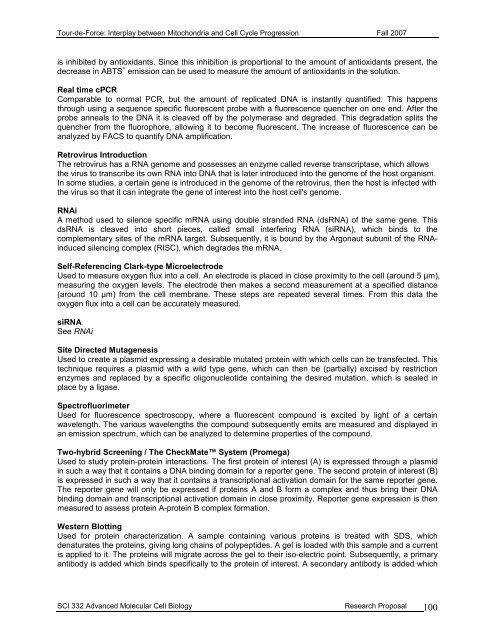Tour-de-Force
Tour-de-Force
Tour-de-Force
You also want an ePaper? Increase the reach of your titles
YUMPU automatically turns print PDFs into web optimized ePapers that Google loves.
<strong>Tour</strong>-<strong>de</strong>-<strong>Force</strong>: Interplay between Mitochondria and Cell Cycle Progression Fall 2007is inhibited by antioxidants. Since this inhibition is proportional to the amount of antioxidants present, the<strong>de</strong>crease in ABTS + emission can be used to measure the amount of antioxidants in the solution.Real time cPCRComparable to normal PCR, but the amount of replicated DNA is instantly quantified. This happensthrough using a sequence specific fluorescent probe with a fluorescence quencher on one end. After theprobe anneals to the DNA it is cleaved off by the polymerase and <strong>de</strong>gra<strong>de</strong>d. This <strong>de</strong>gradation splits thequencher from the fluorophore, allowing it to become fluorescent. The increase of fluorescence can beanalyzed by FACS to quantify DNA amplification.Retrovirus IntroductionThe retrovirus has a RNA genome and possesses an enzyme called reverse transcriptase, which allowsthe virus to transcribe its own RNA into DNA that is later introduced into the genome of the host organism.In some studies, a certain gene is introduced in the genome of the retrovirus, then the host is infected withthe virus so that it can integrate the gene of interest into the host cell's genome.RNAiA method used to silence specific mRNA using double stran<strong>de</strong>d RNA (dsRNA) of the same gene. ThisdsRNA is cleaved into short pieces, called small interfering RNA (siRNA), which binds to thecomplementary sites of the mRNA target. Subsequently, it is bound by the Argonaut subunit of the RNAinducedsilencing complex (RISC), which <strong>de</strong>gra<strong>de</strong>s the mRNA.Self-Referencing Clark-type Microelectro<strong>de</strong>Used to measure oxygen flux into a cell. An electro<strong>de</strong> is placed in close proximity to the cell (around 5 µm),measuring the oxygen levels. The electro<strong>de</strong> then makes a second measurement at a specified distance(around 10 µm) from the cell membrane. These steps are repeated several times. From this data theoxygen flux into a cell can be accurately measured.siRNASee RNAiSite Directed MutagenesisUsed to create a plasmid expressing a <strong>de</strong>sirable mutated protein with which cells can be transfected. Thistechnique requires a plasmid with a wild type gene, which can then be (partially) excised by restrictionenzymes and replaced by a specific oligonucleoti<strong>de</strong> containing the <strong>de</strong>sired mutation, which is sealed inplace by a ligase.SpectrofluorimeterUsed for fluorescence spectroscopy, where a fluorescent compound is excited by light of a certainwavelength. The various wavelengths the compound subsequently emits are measured and displayed inan emission spectrum, which can be analyzed to <strong>de</strong>termine properties of the compound.Two-hybrid Screening / The CheckMate System (Promega)Used to study protein-protein interactions. The first protein of interest (A) is expressed through a plasmidin such a way that it contains a DNA binding domain for a reporter gene. The second protein of interest (B)is expressed in such a way that it contains a transcriptional activation domain for the same reporter gene.The reporter gene will only be expressed if proteins A and B form a complex and thus bring their DNAbinding domain and transcriptional activation domain in close proximity. Reporter gene expression is thenmeasured to assess protein A-protein B complex formation.Western BlottingUsed for protein characterization. A sample containing various proteins is treated with SDS, which<strong>de</strong>naturates the proteins, giving long chains of polypepti<strong>de</strong>s. A gel is loa<strong>de</strong>d with this sample and a currentis applied to it. The proteins will migrate across the gel to their iso-electric point. Subsequently, a primaryantibody is ad<strong>de</strong>d which binds specifically to the protein of interest. A secondary antibody is ad<strong>de</strong>d whichSCI 332 Advanced Molecular Cell Biology Research Proposal 100
















